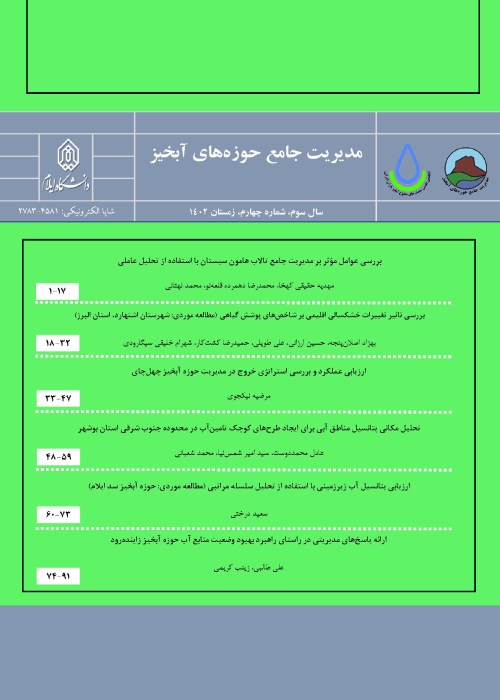Evaluating the effectiveness of MISDc and GR4J rainfall-runoff models in simulating the daily discharge of ChamAnjir Khorramabad watershed
Author(s):
Article Type:
Research/Original Article (دارای رتبه معتبر)
Abstract:
Extended AbstractIntroductionRepresentation of natural phenomena through hydrological models is very important for planning and management of water resources, because these models provide the possibility of investigating natural processes and evaluating modeling in different designs and are of great importance in management decisions. Hydrological models are a simplified representation of the real hydrological system, which help to study the functioning of the basin in response to various inputs and to understand the hydrological processes better. Considering the diversity of hydrological models, it is difficult to choose each model for each task, and there is a need for a comparative evaluation of models to determine the capability each model in the study area. Choosing a model from complex models that require many inputs and are difficult to work with or simple models that are easy to work with is considered important for water resource planners. Also, knowing the accuracy of the models in the simulation process is important and requires investigation. In this study, two hydrological models, MISDc and GR4J, were used to simulate the flow of Cham Anjir watershed. The results of the models show that both models have an acceptable ability to simulate the flow of the studied area, but the MISDc model has a higher ability to simulate the flow, and this model can simulate the peak discharges better than the GR4j model. The advantage of these models is that they are free and the data of these models are few and available.
Materials and methods
In this research, the efficiency of MISDc and GR4j models was evaluated. The basic data used includes observational data of temperature, precipitation, discharge, and evaporation and transpiration in the period 2008-2020 from 3 selected stations in the region and its surroundings. The required data of MISDc model are: daily data of precipitation, temperature and discharge, and the required data of GR4J include daily data of precipitation, evaporation and transpiration, and discharge. The data were given to the models after preparation in MATLAB software, and each model was executed separately. The model performance evaluation process is of fundamental importance during the model development and calibration process. Various indicators are presented and used to evaluate the models. The performance evaluation of two models was investigated through NS and R2 methods.Results and Discussion
In order to check the performance of the two models in the period of 2008-2020, data was prepared. In order to recalibrate the models, a 9-year period was determined and to check the validity of the models, a 4-year period was determined. After entering the data into the MATLAB software for the purpose of simulation, the parameters of the models were changed manually to obtain the most appropriate values and the calibration stage was performed. Next, in the validation phase, the models optimal parameters were fixed, the new statistical period for the model was defined, and the model was implemented. Examining the performance of the two models during the calibration and validation stages shows the good performance of the two models in simulating the daily flow of Cham Anjir basin. The results of Nash coefficients evaluation and determination in the calibration stage for the MISDc model are 0.699 and 0.717, respectively, and for the GR4j model are 0.54 and 0.597 respectively. The results of the validation stage for the MISDc model are 0.794 and 0.851 respectively, and for the GR4j model are 0.70 and 0.715, respectively. These results show that the MISDc model performs better than the GR4j model. The MISDc model has been able to simulate the daily flow of the studied area well, especially in the peak discharges, and the GR4j model, due to its good simulation, has not been able to estimate the peak discharges as well as the previous model.Conclusion
In this research, to evaluate the performance of two MISDc and GR4j models in simulating the runoff of Cham Anjir basin, the data of precipitation, temperature, evaporation and transpiration, and discharge were used in the statistical period of 2008-2020. Then, the stage of data calibration, validation, and evaluation of the model's performance was carried out and examined. The results of the investigations show the good performance of the two models and the relative superiority of the MISDc model to the GR4j model. The results obtained in this research are close to the results of research conducted in different places, so according to the results obtained from the models, it can be said that the models can be used in the studies of water resources in the region, and it is also suggested that the models be used for estimation of runoff in similar areas.Keywords:
Language:
Persian
Published:
Journal of Integrated Watershed Management, Volume:3 Issue: 3, 2023
Pages:
84 to 94
magiran.com/p2633567
دانلود و مطالعه متن این مقاله با یکی از روشهای زیر امکان پذیر است:
اشتراک شخصی
با عضویت و پرداخت آنلاین حق اشتراک یکساله به مبلغ 1,390,000ريال میتوانید 70 عنوان مطلب دانلود کنید!
اشتراک سازمانی
به کتابخانه دانشگاه یا محل کار خود پیشنهاد کنید تا اشتراک سازمانی این پایگاه را برای دسترسی نامحدود همه کاربران به متن مطالب تهیه نمایند!
توجه!
- حق عضویت دریافتی صرف حمایت از نشریات عضو و نگهداری، تکمیل و توسعه مگیران میشود.
- پرداخت حق اشتراک و دانلود مقالات اجازه بازنشر آن در سایر رسانههای چاپی و دیجیتال را به کاربر نمیدهد.
In order to view content subscription is required
Personal subscription
Subscribe magiran.com for 70 € euros via PayPal and download 70 articles during a year.
Organization subscription
Please contact us to subscribe your university or library for unlimited access!


